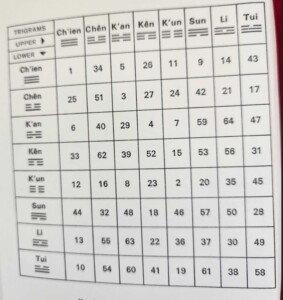 You may be familiar with the practice of Feng Shui and some of the symbolism associated with the Eight Trigrams. Each “trigram” is associated with a part of the body, colors, an element, a family member, and a direction. These trigrams are each symbolized with three lines. The word “trigram” means “three lines.” The lines can be broken or solid and in a certain order to depict the unique trigram and direction.
You may be familiar with the practice of Feng Shui and some of the symbolism associated with the Eight Trigrams. Each “trigram” is associated with a part of the body, colors, an element, a family member, and a direction. These trigrams are each symbolized with three lines. The word “trigram” means “three lines.” The lines can be broken or solid and in a certain order to depict the unique trigram and direction.
For instance, the Qian Trigram is three solid lines stacked on top of each other and associated with the direction of Northwest (post-heaven sequence) and the father in the family structure. The Kun trigram is three broken lines, symbolic of the direction of Southwest (post-heaven sequence) and the image of a mother.
What the heck is “post-heaven sequence?” Some people reading this know what this means, but for the lay person let’s just say that there are two arrangements of the trigrams in relation to the directions associated with them. We have something called the “pre-heaven sequence” which is used for different types of insight in a Feng Shui analysis and it is the arrangement of the Eight Trigrams which is used less for practical applications, but still important and fundamental of Chinese metaphysics.
These same three-lined symbols are grouped in pairs to form “hexagrams.” And it is the 64 hexagrams of the I-Ching (also written Yi Jing) which are symbolic of profound and mystical advice which adherents seek when they turn to the I-Ching for inspiration. We can say that the I-Ching is an ancient Oracle or Book of Divination. There is even a ring on the Chinese Feng Shui compass that identifies the 64 hexagrams and their use in a Feng Shui audit.
When I was first trying to decide if Feng Shui was really my destined professional calling, I threw the coins to do the simple calculations on the energy assigned to the timing of my question. The answer I got from the I-Ching? I got hexagram #55 which translates as “Feng.” It is the pairing of the two trigrams: Thunder above (Zhen Trigram) and Fire Below (Li Trigram). It was more than ironic. This might be the equivalent of wondering if you should be doing something specific with your life and randomly opening up a book to a Chapter Title that says “You Are Already Doing What You Are Meant to Do.”
You may assume the Trigrams and the I-Ching are irrelevant to modern times, but early on in my studies of Chinese metaphysics, an acquaintance sent me a book on the Trigrams in relation to DNA. We don’t know who or how many people originally figured out these mathematical correlations, but they surely happened over long periods of time and after meticulous observation of the cycles of nature. More theories about the Trigrams are continuing to evolve in modern applications and interpretations. What we have been gifted with from our feng shui forefathers is still potent and relevant as ever.
Eight Trigram Theory is quite practical and predictable and there are many applications that can be used to help people. For example, the Zhen trigram is associated with the direction of east and the eldest son. If a house is missing the east sector of the floor plan, it can make it harder for a couple living there to conceive a baby boy. If a family moves into a house with a missing east sector, the eldest son in the family may have some struggles or some thing wrong with his health. If the east sector of a house has something wrong with it or in ill-repair, like a crack in the foundation, this could also harm the eldest son in the family. The more you learn about the trigrams, the more you will see them as a mirror to our lives.
The question of which came first: Feng Shui or I-Ching may never be known, but the Trigrams are fundamental to both divination techniques, as they are in Nine Star Ki and Chinese medicine. While we know when the I-Ching came into being in a written format, we really don’t know how long it was used before before that or as an oral tradition.
Likewise, we know when certain Schools of Feng Shui came into use on a large scale, but no one can tell us when these styles were first discovered or used before those certain teachers were recognized or became associated with the style. For example, Xuan Kong Fei Xing (Flying Star School of Feng Shui) may have been popularized just centuries ago, but the essence of it is integral to the whole of Chinese metaphysics.
Author: Kartar Diamond
Company: Feng Shui Solutions ®
From the Feng Shui History and Culture Blog Series
